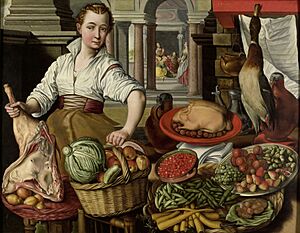Joachim Beuckelaer facts for kids
Quick facts for kids
Joachim Beuckelaer
|
|
|---|---|
 |
|
| Born | c. 1533 |
| Died | c. 1570/4 (aged 37-40) |
| Nationality | Dutch (Flemish) |
|
Notable work
|
|
Joachim Beuckelaer (born around 1533 – died around 1570/4) was a Flemish painter. He was famous for his detailed paintings of market and kitchen scenes. These paintings often showed lots of food and kitchen items. He also painted still lifes, which are pictures of objects that don't move, without any people in them. His unique style greatly influenced how still life art developed in Northern Europe and Italy.
Contents
Life of Joachim Beuckelaer
We don't know many details about Joachim Beuckelaer's life. He was born in Antwerp, a city in what is now Belgium. His family included several painters. He was likely the son of Mattheus Beuckeleer and the brother of Huybrecht Beuckeleer. Huybrecht also became a painter, and sometimes their works were confused.
Joachim probably learned to paint in the workshop of his uncle, Pieter Aertsen. Aertsen was well-known for his market and kitchen scenes. In 1560, Beuckelaer became an independent master in the Guild of Saint Luke in Antwerp. This meant he could open his own workshop and take on students.
Beuckelaer stayed in Antwerp his whole career. He continued to develop the painting themes his uncle started. Many people believe he even became more skilled than his uncle. The exact year he died is not known, but it was likely between 1570 and 1574.
Beuckelaer's Artworks
Joachim Beuckelaer was best known for his market and kitchen scenes. These paintings showed many different foods and household items in great detail. In the early 1560s, he also painted some religious works. He even created designs for stained glass.
Market and Kitchen Scenes
Beuckelaer's market scenes often included small biblical stories in the background. A great example is his Four Elements series, which is now in the National Gallery, London. For instance, in the painting Water, you can see a fish market with twelve different kinds of fish. These fish represent the twelve disciples of Jesus. In the background, through an archway, you can see Jesus walking on the Sea of Galilee. He is making fish appear in empty nets after his resurrection.
Over time, both Beuckelaer and Aertsen started to separate the food displays from the religious stories. Their later works focused more on kitchens or markets themselves. They often showed women involved in these activities. Beuckelaer's later paintings showed even more food items. They also brought the peasant women selling these items more to the front of the painting. He also painted several fish stalls, sometimes with religious scenes in the background, but sometimes with no extra story at all. Around 1563, Beuckelaer also experimented with painting more detailed landscapes. This new style influenced other artists in Antwerp.
Still Life Paintings
One of Beuckelaer's unique still life paintings without people is Kitchen scene with Christ at Emmaus (around 1660/65). This painting shows a kitchen full of ingredients for a big meal. You can see vegetables, fruits, nuts, poultry, and a large piece of meat. Tablecloths and dishes are also visible. In the background, Beuckelaer painted the biblical story of Christ at Emmaus. The main focus of the painting is the detailed dinner preparations, while the religious story is pushed to the back. These types of scenes are seen as early examples of the still life paintings that became popular in the 17th century, where narrative elements disappeared completely.
His still life of a slaughtered animal, called Slaughtered pig (Wallraf-Richartz Museum), painted in 1563, is likely the earliest known painting of this subject.
Working with Other Artists
Beuckelaer also painted the figures (people) in the works of other artists. These included Anthonis Mor and Cornelis van Dalem. A writer from the 17th century, Karel van Mander, said that Beuckelaer could only sell his paintings for low prices. He claimed that Beuckelaer's works only became valuable after he died. However, his later paintings were very large, and he made many versions of them in his workshop. This suggests that he was quite successful, at least towards the end of his life.
Painting Techniques
Studies of Beuckelaer's painting methods show that he often reused his own ideas. He would trace patterns of grouped items to create new pictures that looked different. This technique helped him paint more efficiently. It saved him time and effort.
Influence on Other Artists
Beuckelaer's work had a big impact on other painters. The Flemish artist Frans Snyders, who painted still lifes and animals, was inspired by Beuckelaer's market scenes. Painters in Northern Italy, like Vincenzo Campi and Jacopo Bassano, were also influenced by his unique style.
See also
 In Spanish: Joachim Beuckelaer para niños
In Spanish: Joachim Beuckelaer para niños




